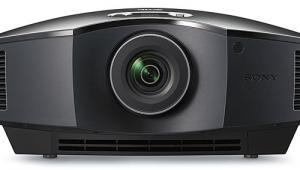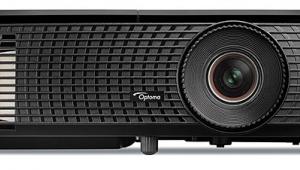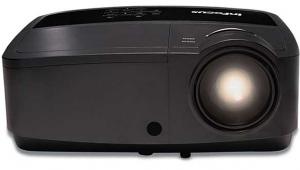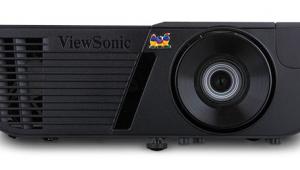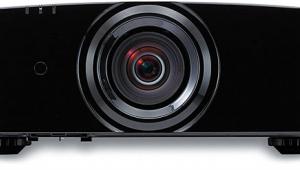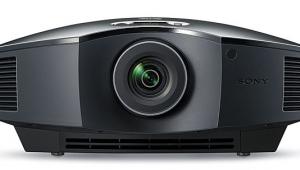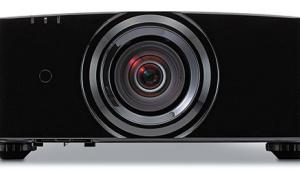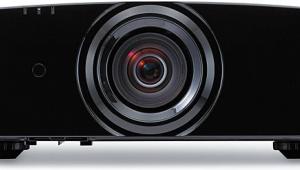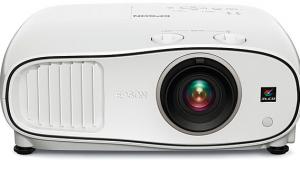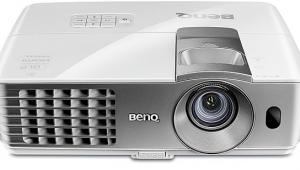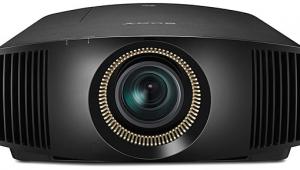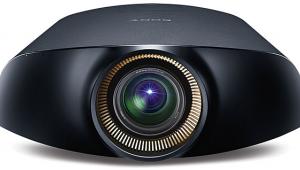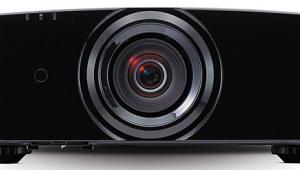Optoma HD33 3D DLP Projector

Like it or not, 3D compatibility is becoming nearly ubiquitous in midrange to high-end flat panels and projectors. But what about those who are looking for an entry-level projector with 3D? Are they out of luck? Not according to Optoma, whose HD33 DLP projector sells for less than $1,500, making it one of the least expensive 1080p 3D projectors on the market.
Features
Interestingly, the HD33 can trigger the 3D effect in one of two ways—using an external RF (radio frequency) emitter or DLP-Link, which flashes a single white frame on the screen at regular intervals. The white frames synchronize compatible active-shutter glasses with the alternating left and right images, just as the RF emitter does with RF-compatible glasses. Of course, most 3D displays use IR (infrared) sync, which means the IR glasses must face the screen or emitter to avoid losing sync; this is not a problem with RF. Naturally, RF and DLP-Link glasses are incompatible with each other, but either way, you don’t need a special polarization-preserving screen, as with projectors that use passive-polarized glasses.
The emitter is included with the projector, but glasses must be purchased separately for $99 each. Optoma sent me a pair of RF glasses, and I found them quite comfortable. They use batteries that are recharged via USB from a computer.
Aside from providing two types of active-glasses sync, the HD33 can handle all the common 3D signal formats—frame packing (used on 3D Blu-rays), side by side (used in some 3D broadcast signals), and top/bottom (used in other 3D broadcasts)—that are selected automatically according to the incoming signal. It can also convert 3D images to 2D using only the left or right image.
Several related features are grouped in the menu under the PureEngine moniker. These include PureDetail, which performs edge enhancement; PureColor, which, according to the manual, “utilizes a new color-processing algorithm and enhancements to enable the picture’s vividness to be significantly increased”; and Pure-Motion, which is Optoma’s implementation of 120-hertz frame interpolation.
In addition to 16:9 and 4:3 aspect-ratio modes, the HD33 provides Native mode, which presents the incoming image with no scaling whatsoever, and LBX, which scales non-anamorphic letterbox images to fill a 16:9 screen. This mode can also be used with an anamorphic lens to fill a 2.35:1 screen, although I doubt any buyer of this model will do so, since such a lens costs several times what the projector does. A separate SuperWide mode scales the image to an aspect ratio of 2.0:1, which I find objectionable and would never recommend. Much more useful is the Edge Mask control, which crops a bit around the image without overscanning to hide so-called digital hash that sometimes appears in broadcast images.
My primary gripe in the features department—and it’s a big one that applies to other inexpensive Optoma projectors—is the lack of a lens shift function for setup. This means the projector must be placed in a very specific location to fill a given screen size. Yes, there’s an optical-zoom control on the lens, but its range is very limited. There’s also a digital zoom control in the menu, but this reduces resolution, so I avoid it at all costs. Similarly, the HD33 provides a vertical keystone control to compensate for placing the projector at the wrong height, but this also degrades the picture quality and should be avoided if possible. The best solution is to mount the projector on a bracket from the ceiling so it can be placed at the correct location with respect to the screen and not be in anyone’s way.
 User Interface
User Interface
As with most projectors, the HD33’s remote is small, and the layout is well organized with dedicated input selection buttons, which I wish more TV remotes had. It also provides dedicated buttons to directly access many often-used functions, which is great. The remote is backlit, but only cryptic icons on the buttons can be seen in the dark; the text labels are on the remote body and not illuminated. Also, the illumination is bright blue; it should be red to avoid affecting dark-adapted vision. Another drawback is the lack of an exit button to exit the menu directly; as it is, you must back out of the menu one level at a time. On the plus side, the remote’s infrared beam is plenty strong enough to bounce off the screen and back to the projector.
The HD33’s menu is a model of excellent organization, and once opened, it returns to the previously selected submenu, as it should. Also, the selected picture control drops to the bottom of the screen and the rest of the menu disappears, making it easy to adjust the control while looking at an image. However, the menu disappears after about 13 seconds of inactivity, which is a bit too quick for me—I wish there was a menu timeout setting. The one exception I found is the set of grayscale calibration controls, which remains on the screen until you exit—a big help when calibrating the projector.
Setup
The lack of lens shift made placement tricky in the tight dimensions of Room 2 of our testing studio, but I was eventually able to set it up without having to resort to keystone correction or digital zoom.
Out of the box, the color space was set to Auto, which clipped above white and below black with the RGB signal from a VideoForge signal generator. When I selected this control’s RGB (0-255) setting, above white and below black restored, although the level of 254 was almost completely clipped at any setting of the contrast control. At the highest setting without more clipping, the peak-white level was nearly 32 foot-lamberts in the STD lamp mode on my relatively small 76-inch-wide, 16:9, Stewart Studiotek 100 screen (gain 1.0), so I backed off the contrast to bring peak-white level to around 16 ft-L. (The screen is actually 100 inches wide with an aspect ratio of 2.35:1 but was used here only in a centered, 16:9 area.)
Unfortunately, with the color space mode set to RGB (0-255), the three Blu-ray players I tried produced entirely wrong colors because they defaulted to sending YCbCr. I was able to reset the Oppo BDP-83 and LG BX580 to output RGB, which corrected the problem, but the Samsung BD-D6900 has no color space control, so I couldn’t use it with the Optoma set to accept RGB. Interestingly, setting the projector’s color space to YUV fixed the problem with the Samsung.
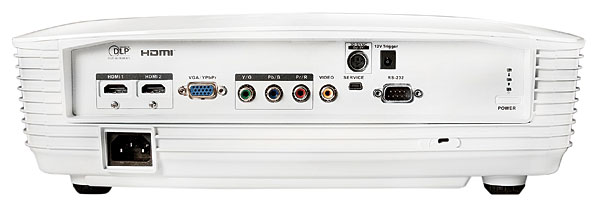
If the HD33 receives RGB via HDMI, its color and tint controls are unavailable, but the color bars’ test pattern looked perfect viewed through a blue filter. (The HD33 doesn’t have a blue-only mode, which would make it possible to check the color bars without the need for a blue filter.) The setting for the sharpness control is critical—one click too high resulted in obvious edge enhancement, while one click too low visibly softened the image.
The Reference display mode was the closest to correct out of the box, so I used it as my starting point for 2D calibration with all PureEngine features off. The grayscale measurements were fairly close to where they were supposed to be, although the gamma was only 2.0 and the color points for green, yellow, and red were moderately oversaturated. Also, the luminance of green was way low, and all but magenta had significant errors in hue. With no color or tint controls available in RGB mode and no color-management system, I experimented and found that setting PureColor to 1 yielded the lowest color errors overall. After calibration, the grayscale results were generally excellent (see HT Labs Measures), but the gamma was still too low at 2.1. I fiddled with the gamma controls and ended up with an average gamma of 2.3, which helped the picture look less washed out.
- Log in or register to post comments
